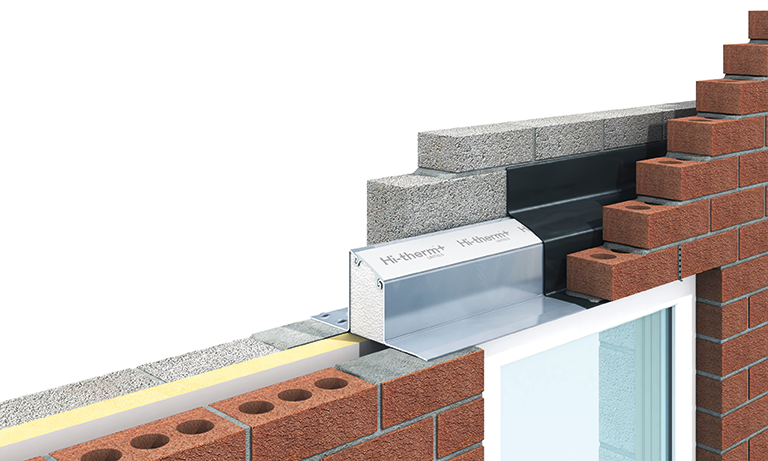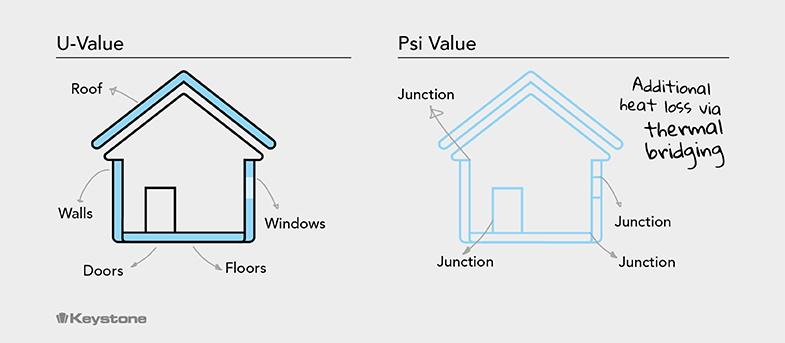Energy Efficient Design - Addressing Thermal Bridging in Steel Lintels
If buildings are designed to meet Part L regulations and carbon reduction targets, then it is essential specifiers understand the impact of thermal bridging. With a traditional steel lintel potentially creating a major thermal bridge in a building, correct lintel specification can have a significant impact on a building's fabric efficiency.
Ben Cheetham, National Specification Manager at Keystone Lintels, looks at the detailing around junctions and how this important structural element can be designed to be more thermally efficient and with better buildability.
Contents |
[edit] Introduction
Preventing heat loss by addressing thermal bridging is growing in importance; particularly with the UK government aiming to create more energy efficient homes and attain its ultimate goal: carbon-neutrality by 2050. Indeed, research carried out by BRE found that thermal bridging can account for up to 30% of heat loss from buildings.
[edit] Explaining ‘the bridge’
A thermal bridge is a localised area in the thermal envelope of a building where there is increased heat loss compared to the surrounding area. For example, where a traditional steel lintel spans a window or door opening and interrupts the insulation layer in the cavity wall, a clear path for heat to escape is provided and the thermal efficiency is compromised.
Non repeating thermal bridges such as these are assessed using thermal modelling software, and their impacts on the building’s energy performance must be calculated independently in addition to U-values.
[edit] Heat loss and lintels
The majority of lintels in domestic-scale dwellings are made from steel for a number of reasons, such as providing more design flexibility and easier onsite handling due to their lightweight design compared to other alternatives. However, steel has a high conductivity value, and with lintels typically spanning across long lengths in a typical build, it’s no surprise they can have a significant impact on heat loss via thermal bridging. Therefore, taking into account the thermal performance of lintels at design and specification stage is more important than ever.
A lintel design which incorporates a thermal break will outperform and be much more thermally efficient than a standard lintel. For instance, Keystone’s Hi-therm+ lintels use a patented combination of a polymer isolater and galvanised steel to bond the internal and external walls together by spanning the intervening gap. The polymer isolater provides a powerful thermal break in the lintel and virtually eliminates this key thermal bridge.
The Hi-therm Lintel has a low thermal conductivity with a Psi value of 0.03 to 0.06 W/m.K.
[edit] Fabric first
A fabric-first approach has for some time been supported by the housebuilding industry. Its approach factors in a number of aspects such as:
- Having high levels of thermal insulation and excellent air tightness levels.
- Maximising building orientation for solar gains,
- Designing out thermal bridging.
The benefits of this approach as a first step in building design are increasingly widely recognised, and ongoing research continues to reinforce the significant positive impact this approach can have economically, environmentally and socially.
The reduction in CO2 emissions achieved through fabric measures is built-in for the life of the building and therefore can ensure that the energy demand and CO2 emissions of a site remains low.
With junctions above openings in buildings particularly vulnerable to heat loss through thermal bridging, details and structural elements such as lintels help to create energy efficient buildings. Adopting a fabric-first approach in the first instance will help the building continue to perform as-designed and go some way to maximising the overall efficiency of UK homes ensuring they are well positioned for future regulatory changes.
For more information contact Keystone Lintels.
--Keystone LINTELS 15:43, 28 Aug 2020 (BST)
[edit] Related articles on Designing Buildings Wiki
Featured articles and news
Grenfell Tower fire – eight years on
A time to pause and reflect as Dubai tower block fire reported just before anniversary.
Airtightness Topic Guide BSRIA TG 27/2025
Explaining the basics of airtightness, what it is, why it's important, when it's required and how it's carried out.
Construction contract awards hit lowest point of 2025
Plummeting for second consecutive month, intensifying concerns for housing and infrastructure goals.
Understanding Mental Health in the Built Environment 2025
Examining the state of mental health in construction, shedding light on levels of stress, anxiety and depression.
The benefits of engaging with insulation manufacturers
When considering ground floor constructions.
Lighting Industry endorses Blueprint for Electrification
The Lighting Industry Association fully supports the ECA Blueprint as a timely, urgent call to action.
BSRIA Sentinel Clerk of Works Training Case Study
Strengthening expertise to enhance service delivery with integrated cutting-edge industry knowledge.
Impact report from the Supply Chain Sustainability School
Free sustainability skills, training and support delivered to thousands of UK companies to help cut carbon.
The Building Safety Forum at the Installershow 2025
With speakers confirmed for 24 June as part of Building Safety Week.
The UK’s largest air pollution campaign.
Future Homes Standard, now includes solar, but what else?
Will the new standard, due to in the Autumn, go far enough in terms of performance ?
BSRIA Briefing: Cleaner Air, Better tomorrow
A look back at issues relating to inside and outside air quality, discussed during the BSRIA briefing in 2023.
Restoring Abbotsford's hothouse
Bringing the writer Walter Scott's garden to life.
Reflections on the spending review with CIAT.
Retired firefighter cycles world to raise Grenfell funds
Leaving on 14 June 2025 Stephen will raise money for youth and schools through the Grenfell Foundation.
Key points for construction at a glance with industry reactions.
Functionality, visibility and sustainability
The simpler approach to specification.

























